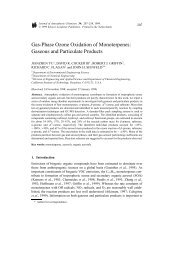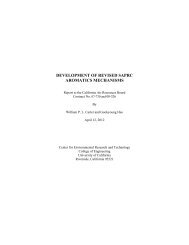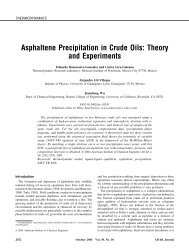Density functional theory for chemical engineering: From capillarity ...
Density functional theory for chemical engineering: From capillarity ...
Density functional theory for chemical engineering: From capillarity ...
Create successful ePaper yourself
Turn your PDF publications into a flip-book with our unique Google optimized e-Paper software.
Figure 10. <strong>Density</strong> profiles of a Lennard–Jones fluid (A)<br />
near a hard wall and (B) in an attractive slit<br />
pore.<br />
The points are results from Monte Carlo simulation; the<br />
solid and dashed lines are predictions of DFT using the<br />
direct correlation function and the mean-field approximation,<br />
respectively. 54<br />
provide useful insights <strong>for</strong> applications in oil recovery, lubrication,<br />
coating technology, and pollution control. 139<br />
Wetting Transitions<br />
Wetting refers to the disappearance of the contact angle of<br />
three coexisting phases, such as a liquid droplet setting on a<br />
solid substrate surrounded by a saturated vapor phase. The<br />
phenomenon is pertinent to the spreading of paint on a wall,<br />
spraying of an insecticide on leaves, extrusion of textile fibers<br />
from a liquid solution, lubrication of gears, aircraft deicing, and<br />
crude oil recovery from porous sandstones. The literature on<br />
wetting phenomena is vast; a number of excellent reviews have<br />
been published on both experiment and <strong>theory</strong>. 143,144 Below we<br />
review only some salient features of wetting behavior in the<br />
context of recent work based on DFT.<br />
A simple fluid near a planar wall<br />
Most theoretical work on wetting phenomena has been focused<br />
on a simple model system consisting of a vapor phase<br />
(saturated or unsaturated) in direct contact with a smooth<br />
planar solid. Because of the surface attraction, a thin layer of a<br />
liquid-like film is <strong>for</strong>med at the solid substrate even when the<br />
vapor phase is unsaturated. As shown in Figure 11, at a given<br />
temperature the film thickness increases monotonically with<br />
the vapor pressure and reaches a finite value below the wetting<br />
temperature T w , but diverges otherwise. Below T w , a bulk<br />
liquid partially wets the surface. In this case, the contact angle<br />
is related to the vapor–liquid, vapor–solid, and liquid–solid<br />
interfacial tensions according to Young’s equation. Above T w ,<br />
the saturated liquid completely wets the surface and the contact<br />
angle becomes zero. At certain conditions, a thin–thick film<br />
transition may occur below the saturation pressure. This phenomenon<br />
is known as prewetting. The prewetting transition has<br />
its own critical point referred to as the surface critical temperature<br />
T S C . Above T S C , there is no coexistence of the thin and<br />
thick films. Depending on the strength of the surface-fluid<br />
potential, the surface critical temperature can be either below<br />
or above the bulk critical point.<br />
In analogy to bulk phase transitions, a wetting transition can<br />
be first or second order, depending on whether the film thickness<br />
diverges discontinuously or continuously as the temperature<br />
increases. ‡‡ In some special cases, the second-order wetting<br />
transition may be preceded by a first-order, microscopicto-mesoscopic<br />
film transition known as pseudopartial<br />
wetting 145 or frustrated complete wetting. 146 Figure 12 shows<br />
three wetting scenarios. The boundary between first-order and<br />
second-order wetting transitions is shown in terms of the surface<br />
energy when the attraction between the substrate and fluid<br />
is short range.<br />
Prewetting transition was first predicted by Ebner and<br />
Samm 147 using a gradient expansion of the Helmholtz energy<br />
<strong>functional</strong> and by Cahn 40 using van der Waals’ square-gradient<br />
<strong>theory</strong>. The adsorption isotherm shows a discontinuity at the<br />
condition of a prewetting transition, where a thin liquid film<br />
coexists with a thick liquid film at the same temperature and at<br />
a pressure below the saturation. The density profiles of both the<br />
thin and thick films satisfy the variational equation (Eq. 4) and<br />
they yield the same grand potential. Similar prewetting transitions<br />
were discovered later in the binary liquid mixture methanol<br />
and cyclohexane in contact with the coexisting vapor<br />
phase. 148 Because of the drastic approximations used in the<br />
early theories, the existence of the first-order prewetting transition<br />
resulted in controversy that stimulated a number of<br />
‡‡ At the wetting transition, the liquid always coexists with a saturated vapor. By<br />
contrast, prewetting occurs at a pressure below the saturation.<br />
Figure 11. Film thickness vs. vapor pressure at different<br />
temperatures.<br />
Here T w wetting temperature, T C bulk critical temperature,<br />
and T C S surface critical temperature. [Color figure<br />
can be viewed in the online issue, which is available at<br />
www.interscience.wiley.com.]<br />
1180 March 2006 Vol. 52, No. 3<br />
AIChE Journal
















